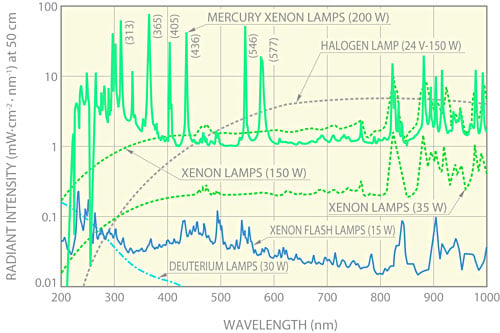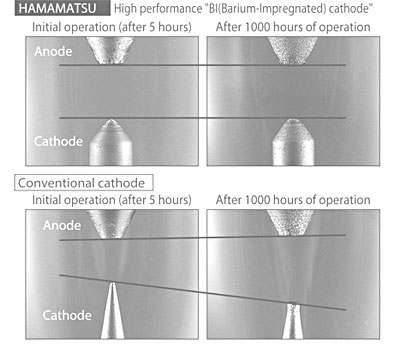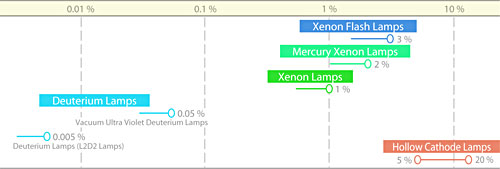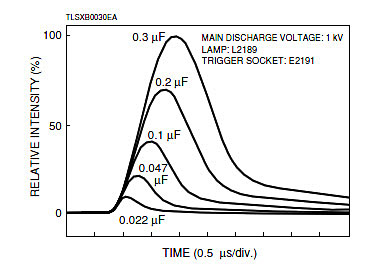By Travis Iguchi, Samir Patel, and Maridel Lares, Hamamatsu Corp.
As the green evolution continues, light emitting diodes (LEDs) are replacing traditional light sources in many applications. However for applications requiring wavelength ranges that an LED's monochromatic output cannot match, arc discharge lamps are still a more suitable choice. Lamps cover a broader wavelength range, and their major feature is high-intensity emission in the UV region not covered by current LEDs. In this article, we discuss the basic properties of different lamp types — xenon (Xe), mercury-xenon (HgXe), and deuterium (D2) continuous-mode lamps and xenon flash lamps — and their example applications to help you make an informed decision when choosing lamps.
Important parameters for choosing a lamp

Figure 1: Spectral ranges of different lamp types.
When choosing a lamp, it is important to consider the wavelength, light intensity, stability level, and life expectancy needed in the application. The required wavelength range often narrows down the lamp choices. Certain lamps cover a small portion of the electromagnetic spectrum while others cover a broader range (Figure 1). For example, deuterium lamps emit ultraviolet (UV) wavelengths, while xenon and mercury-xenon lamps emit from UV to infrared (IR) wavelengths.
Light intensity is another important characteristic to consider, and whether a continuous or pulsed light is needed. A lamp's intensity is basically proportional to the input power. The higher the input power, the higher the intensity. However, pulsed light sources like xenon flash lamps can provide a very intense light output for several microseconds, about 1000 times higher than continuous-mode lamps. This makes pulsed lighting suited for applications requiring high output power for a short duration.
The lamp's output stability is a very important parameter because it affects measurement accuracy and reliability. Several factors affect a lamp's stability. Temperature, power supply performance, housing design, and position within the arc affect the stability of xenon, mercury-xenon, and deuterium lamps. Lamp discharge voltage, operating frequency, main discharge capacitor, and position within the arc affect a xenon flash lamp's stability.
A lamp's lifetime affects maintenance and running costs of the equipment in which the lamp is installed. Using a lamp with a longer service life reduces maintenance costs and time spent replacing and aligning lamps.
Xenon and mercury-xenon lamps
Xenon and mercury-xenon lamps have cathode and anode electrodes facing each other in a glass bulb filled with gas. Xenon lamps contain high purity xenon gas, while mercury-xenon lamps contain a mixture of xenon gas and mercury. These lamps emit by arc discharge.
Xenon lamps emit a broad spectrum from UV to IR (185-2000 nm) similar to sunlight. They have high output intensity, high stability, and long life. For example, Hamamatsu's 75 W and 150 W xenon lamps (L10725 and L11033 series) have a guaranteed life of 2000 and 3000 hours, respectively. Xenon lamps are suitable light sources for solar simulators, spectrometers, wafer inspection systems, microscopes, and other devices.
Mercury-xenon lamps emit a broad spectrum from UV to IR (185-2000 nm) with sharp peaks in the UV and visible region corresponding to mercury's spectral lines. The sharp emission peaks make mercury-xenon lamps more appropriate than xenon lamps for applications requiring high intensity in the UV region, such as UV curing. Other features of mercury-xenon lamps include high output intensity, high stability, and long service life. They are suitable light sources for wafer inspection systems, film thickness measurement systems, microscopes, UV curing, and other applications.

Figure 2: Comparison of cathode erosion.
When using xenon or mercury-xenon lamps, there are some items to keep in mind including warm-up time, power supply performance, and cathode erosion. After the lamp is turned on, a warm-up period lasting several minutes is required to reach the maximum light output because the gas pressure inside the bulb must first reach equilibrium.
These lamps operate on DC power and require very stable main and trigger power supplies to ensure stable lamp operation. The main power supply must be stable to supply the optimal current to the lamp and to keep the cathode at the optimal temperature. If the cathode temperature is too low, the cathode sputters and causes a shorter lamp lifetime. If too high, the cathode evaporates too fast.
Cathode erosion is a concern because it causes the arc point to fluctuate and move gradually with operating time, affecting the lamp's stability. However, improved electrode materials virtually eliminate this problem. For example, Hamamatsu's xenon and mercury-xenon lamps use a special cathode material that results in negligible erosion even after 1000 hours of operation, unlike conventional lamps without this technology (Figure 2).
Deuterium lamps
Deuterium lamps contain deuterium gas and emit UV light; the wavelength range depends on the lamp's glass material. The lamps emit in one direction only, unlike xenon and mercury-xenon lamps which emit in all directions. They are widely used in spectrometers, HPLC (high performance liquid chromatography), environmental analyzers, and other applications. For applications that require vacuum UV (VUV) wavelengths, deuterium lamps that emit down to 115 nm are available. For example, Hamamatsu's S2D2 VUV light source unit (L10706) can be installed and operated under depressurized conditions for VUV spectroscopy, photoionization, and other applications.
A key characteristic of deuterium lamps is their excellent stability compared to other lamp types (Figure 3). For example, Hamamatsu's deuterium lamps show very small output variations from lamp to lamp, and individual lamps have low fluctuation (short-term stability) and drift (long-term stability) values. Hamamatsu's S2D2 deuterium lamp module (L10671 series), for example, exhibits a typical fluctuation of 0.005% (peak to peak) and a maximum drift value of ±0.25%/hour. Such stability is due to the ceramic electrode structure, which ensures lamp stability even when the ambient temperature fluctuates. Deuterium lamps also have long life and high brightness, and they are being developed to be even brighter. For example, Hamamatsu's new X2D2 lamps have twice the brightness of conventional deuterium lamps. Using a high-brightness lamp helps an instrument have high resolution and high throughput.

Figure 3: Comparison of fluctuation values (a measure of short-term stability) of different lamp types from Hamamatsu. The smaller the value, the more stable the lamp.
When using deuterium lamps, there are some items to keep in mind including power supply performance, warm-up periods, and aperture size. Just like xenon and mercury-xenon lamps, deuterium lamps need a very stable power supply to supply the optimal current and to keep the lamp at the optimal temperature. They also need a warm-up period to allow the lamp to reach thermal equilibrium.
Another item to consider is the aperture size. A deuterium lamp's aperture size affects the light output intensity, but there is a tradeoff between aperture size and difficulty of alignment. Deuterium lamps with a small aperture size (ex. 0.5 mm) are brighter than lamps with a larger aperture (ex. 1.0 mm), but they are more difficult to align in an optical system.
Xenon flash lamps
Xenon flash lamps are compact pulse light sources that emit from UV to IR (160-2000 nm). They are suitable for many applications including medical analysis, environmental analysis, biological research, and factory automation. Compared to continuous-mode lamps, they generate less heat and do not damage samples. Also, they do not require a warm-up period; they are ready for use when turned on. However, they have lower stability than other lamps.

Figure 4: Xenon flash pulse waveforms at different main discharge capacitors.
When using a xenon flash lamp, there are some items to keep in mind. A xenon flash lamp requires a trigger socket and power supply to operate. Easy-to-use modules that integrate all three items, such as Hamamatsu's L9455 and L11035 series, are available. Secondly, shielding should be used to prevent electrical noise.
A third item to keep in mind is that the power supply's capacitor affects the output intensity and pulse width of a flash lamp (Figure 4). A larger capacitor results in higher intensity. Because of the differences in the electrical capacity of capacitors, a larger capacitor generates a longer flash pulse waveform as well. Example applications
Lamps are used in many fields including medical, industrial, analytical, and others. Example applications and suitable lamps are discussed below.
Medical applications
In the medical field, lamps are used in instruments such as endoscopes and blood analyzers. For endoscopes, a xenon lamp is an appropriate light source. Its high output intensity is sufficient to illuminate the area to be viewed, and its steady light output allows the acquisition of clear images. For blood analyzers, deuterium lamps and xenon flash lamps are suitable light sources. They have high brightness and a long lifetime, and each type has advantages and disadvantages. A deuterium lamp has very high stability, but it needs a 20- to 30-minute warm-up period. A xenon flash lamp delivers high intensity in a short time period, and it does not generate as much heat, so samples are not affected. However, it is much less stable than a deuterium lamp.
Industrial applications
Lamps are used in industrial applications such as wafer inspection systems and UV curing equipment. Xenon or mercury-xenon lamps are suitable for wafer inspection systems because the lamps have high output power, good stability, and long life. Mercury-xenon lamps are used for UV curing because many UV-curable epoxies, adhesives, coatings, and inks are dried using UV light corresponding to mercury's spectral lines.
Analytical and other applications
Some analytical instruments employ lamps as light sources. HPLC systems and pollution monitors use deuterium lamps, whose high stability helps ensure good measurement accuracy and reliability. For color analyzers, a xenon flash lamp is a suitable light source. Its advantages include low thermal effects on samples and instantaneous measurement once it is turned on.
Solar simulators are used for checking the performance of solar cells and for degradation testing of materials, as well as in photochemistry and photobiology research. Because a xenon lamp's white light emission is similar to sunlight, this lamp type is ideal as a light source for solar simulators. Lamps continue to play a role in many applications, especially when other types of light sources cannot fulfill the wavelength range required. The wavelength, light intensity, stability, and lifetime requirements of the application determine the appropriate type of lamp to use.